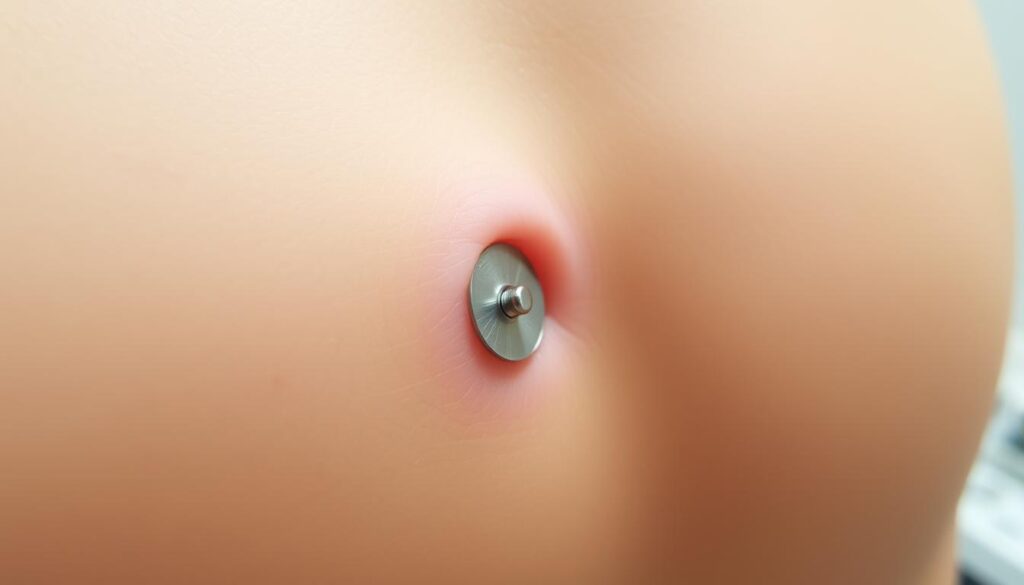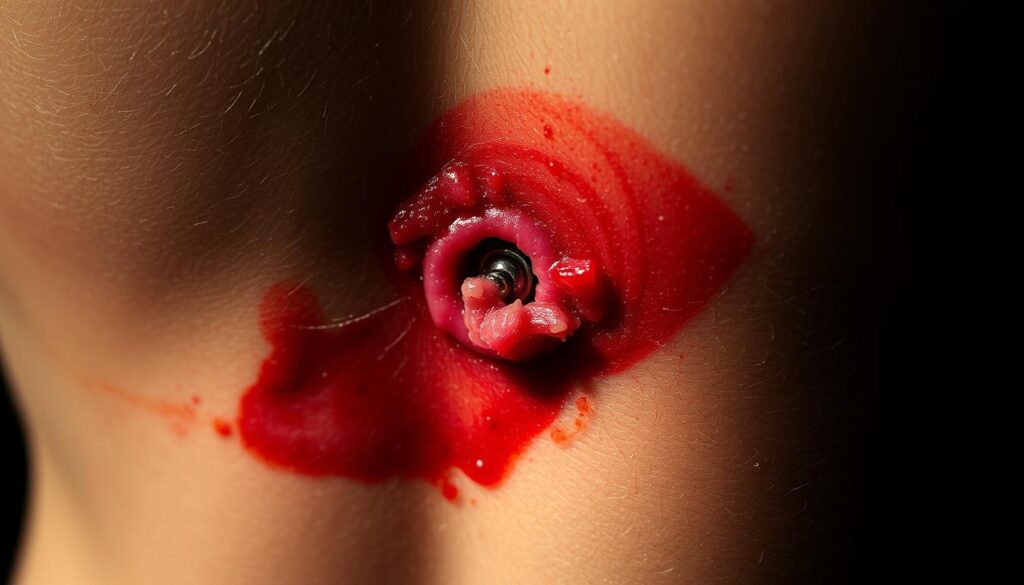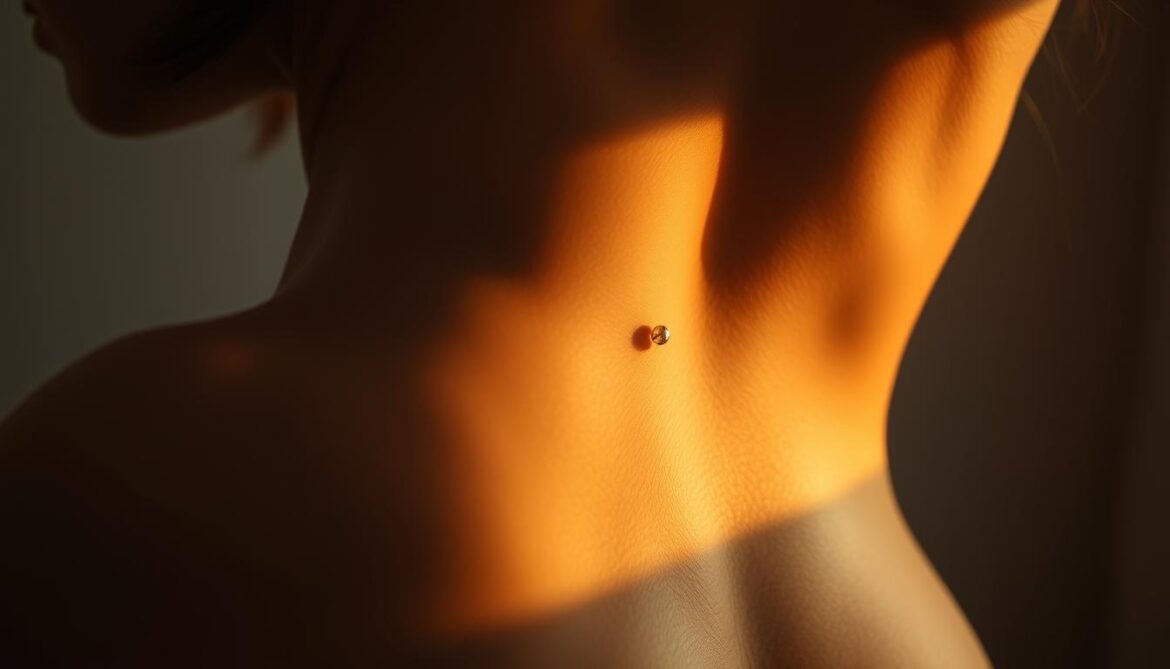Lower back dermal piercings, also known as back dimple piercings, are a bold yet discreet way to express personal style. These small, raised gems sit just above the waistline, offering a sleek contrast between minimalism and edge. As body art trends evolve, this piercing stands out for its blend of elegance and uniqueness.
Whether you’re curious about the process or weighing pros and cons, this guide covers it all. Explore why thousands choose this piercing and how it differs from other body modifications. Learn what to expect from start to finish—from choosing a piercer to maintaining your new jewelry.
Key Takeaways
- Lower back dermal piercings create a subtle raised jewel effect.
- Costs vary based on location and jewelry type.
- Healing takes 2–6 months with proper aftercare.
- Popular for its balance of visibility and versatility.
- Risks include infection if not cared for correctly.
Understanding Lower Back Dermal Piercings
mix art and body anatomy to make striking designs. They are becoming more popular for their unique look.
What Are Back Dimple Piercings?
A back dimple placement is a piercing in the natural lower back indentations, known as Venus dimples. Unlike regular piercings, a dermal anchor piercing has a small, flat disc (the anchor) under the skin. This disc has a visible gem or post above, giving a raised look without a visible entry point.
| Type | Description | Placement | Jewelry |
|---|---|---|---|
| Traditional Piercing | Enters and exits the skin | Common in ear lobes or nose | Hoops, studs |
| Dermal Piercing | Single-point placement with an anchor | Lower back dimples | Dermal anchors |
Why People Choose Lower Back Dermal Piercings
- Lower back dermal piercing makes a bold statement in a simple way.
- They are subtle yet striking for daily wear.
- There’s a wide range of jewelry styles to fit any outfit or body type.
Different Types of Lower Back Piercings
There are many styles and placements to choose from:
- Single Anchor: A single gem in one Venus dimple.
- Paired Set: Two anchors that mirror each other.
- Surface Bar: A straight barbell for linear designs (not true dermal piercings).
You can pick where to place your back dimple placement to match your body and style.
The Lower Back Dermal Piercing Procedure
Before getting a lower back dermal piercing procedure, knowing the steps helps ease nerves. Here’s a clear breakdown of the dermal piercing process:
- Prep work: Wear loose clothing and avoid heavy meals 2-3 hours before. Cleanse the area with a saline solution provided by the studio.
- Marking: The piercer marks the spot using a sterile pen. Adjustments can be made at this stage.
- Insertion: A dermal punch or needle implants the anchor under the skin. Tools like forceps or a punch ensure precise placement.
- Aftercare kit: Receive a post-procedure kit with saline spray, bandages, and care instructions.
Two techniques dominate the dermal piercing process:
| Technique | Microdermal | Transdermal |
|---|---|---|
| Anchor Size | Small, for delicate placements | Larger, for long-term wear |
| Healing Time | 4-6 weeks | 6-8 weeks |
| Placement | Common for lower back dimples | Used for heavier jewelry |
Procedures take 15–30 minutes. Licensed professionals use sterilized tools like dermal punches or 18-14 gauge needles. A licensed piercer ensures safety—never attempt DIY methods. Post-insertion, a small bump forms where the anchor sits under the skin. Always choose studios with health department licenses to minimize risks.
“Communication is key. Ask questions about technique choices—the right approach depends on your anatomy.” — Sarah Lee, certified body piercer
While the lower back dermal piercing procedure might feel intimidating, clear steps and professional care make it manageable. Prioritize studios following CDC guidelines for infection control.
Cost Factors for Back Dimple Piercings
Getting a back dimple piercing is more than picking a design. We’ll look at the back dimple piercing cost and lower back dermal pricing to help you plan.
Average Price Range in the US
Prices change based on where you are and the studio’s standards. Here’s what you might see:
| Region | Average Cost | Notes |
|---|---|---|
| Urban Areas (e.g., NYC, LA) | $120–$150 | Higher demand drives costs upward |
| Rural Areas | $70–$100 | Lower overhead reduces pricing |
Studios in cities often have better equipment and training. This makes lower back dermal pricing higher than in smaller towns.
Additional Expenses to Consider
- Jewelry: Expect $30–$100+ for surgical steel or titanium options.
- Aftercare kits: Saline solutions and care guides add $10–$20.
- Follow-up visits: Some studios charge $20–$50 for checkups.
Finding Reputable Piercers
Price isn’t everything. Look for piercers with:
- State or local health department licenses
- ABA (Alliance of Body Artists) certification
- Clean studios with sterilization protocols
“A cheap price tag can mean corners cut in safety. Ask about aftercare and infection rates.” – Licensed Piercer, NYC
Always check reviews and ask for portfolios. This ensures the piercer’s skill matches the price.
Pain Level: What to Expect During and After
Curious about lower back dermal piercing pain? Most say it’s sharp but quick. They rate it 4-6 on a 1-10 scale, less than chest or genital piercings. The needle pinch is followed by deeper pressure from the anchor.
- During the procedure: A small hole is made, then jewelry is inserted. The anchor’s tension can cause a brief burning feeling.
- Aftercare phase: You might feel some back dimple piercing discomfort for 24-72 hours. The area near the spine might feel more tender.
“Placement matters most. Piercings 2-3 inches from the spine usually have lower sensitivity,” notes industry experts.
Everyone’s experience is different. If you’re anxious, deep breathing can help. Over-the-counter pain relievers like ibuprofen can ease soreness. Also, avoid tight clothes to reduce pressure.
Swelling or redness is normal, but sharp or worsening pain needs a doctor’s check. Most heal in 3-6 weeks, with pain decreasing over time. Be patient and gentle with your healing process.
Healing Process and Timeline
Patience is key in lower back dermal piercing healing. This part explains what to expect during recovery. It also talks about how to see progress and how personal factors affect healing.
Typical Healing Stages
Most people go through three main stages:
- Week 1-2: Swelling and redness are at their peak. The area might be tender to the touch.
- Months 1-3: Scabs start to fade. Jewelry becomes more stable as the tissue adjusts.
- 6-12 Months: Full recovery is reached. Jewelry becomes secure, and the skin fully adapts.
Normal Signs vs. Complications
Healthy healing looks like:
- Mild redness fading daily
- Clear or white discharge
- Gradual reduction in sensitivity
Get help if you notice:
- Persistent redness after 2 weeks
- Yellow/green pus or swelling spikes
- Pain increasing over time
Factors Influencing Healing Time
Your lifestyle affects how fast you heal. Important factors include:
- Immune health: A stronger immune system heals faster
- Activity level: Jobs that keep you moving a lot may slow healing
- Care routine: Keeping the area clean reduces infection risks
Following aftercare steps is crucial for the best results. Small daily actions can make a big difference in a safe, successful back dimple piercing recovery.
Essential Aftercare Guidelines


Proper back dimple piercing aftercare is crucial to avoid infection and ensure smooth healing. Follow this step-by-step guide:
- Clean twice daily with saline solution or a gentle, fragrance-free soap. Pat dry with a clean cloth—never rub.
- Avoid tight clothing or belts that press on the site. Opt for loose fabrics during healing.
- Keep the area dry for 24 hours post-piercing. Limit swimming and heavy sweating for 4-6 weeks.
For lower back dermal piercing care, use mirrors or ask a friend to help inspect hard-to-see areas. Avoid:
- Applying lotions, oils, or first-aid creams
- Touching the piercing with unwashed hands
- Sitting directly on surfaces like car seats for 2-3 weeks
| Symptom | Action |
|---|---|
| Redness or swelling | Continue cleaning. Seek advice if worsening. |
| Pus or (odor) | Contact your piercer immediately. |
| Itching | Resist scratching. Keep clean and moisturized with approved products. |
Consistency is key. Neglecting back dimple piercing aftercare risks migration or loss of the jewelry. Always follow your piercer’s instructions and prioritize hygiene. Healing takes 6-12 months—stay patient and proactive!
Choosing the Right Jewelry for Your Lower Back Dermal Piercing
Choosing the right lower back dermal piercing jewelry is key. It should be safe, comfy, and match your style. Here’s how to pick and care for your jewelry:
Material Options and Their Benefits
Materials are crucial during healing. Start with:
- Implant-grade titanium: It’s safe, doesn’t cause allergies, and lasts long. Great for the start of healing.
- Surgical steel: It’s cheap but avoid it if you’re allergic to nickel.
- Niobium: It’s safe and comes in bright colors.
- Pure gold (14k or higher): It’s fancy but more expensive for long-term wear.
Choose hypoallergenic materials for the first 6–12 months to avoid skin issues.
Popular Jewelry Styles for Back Dimples
| Style | Best For | Size Range |
|---|---|---|
| Gemstones | Elegant, subtle looks | 2–5mm diameter |
| Spikes | Edgy or bold statements | Small, close to skin |
| Themed designs | Personalized flair | Custom sizes (consult a piercer) |
Go for smaller back dimple piercing tops for comfort and to see them. Match your jewelry to your day—simple for everyday, unique for special times.
When and How to Change Your Jewelry
Wait 3–6 months after healing. To change safely:
- Use sterilized tweezers and saline solution.
- Wash your hands and the piercing area well.
- Only swap for jewelry of the same gauge and length.
Changing it yourself can be risky. If unsure, see a pro. Feeling red or sore? Don’t try it yourself and see a piercer right away.
Potential Risks and Complications
Lower back dermal piercings can be stylish, but they also carry risks. Understanding lower back dermal piercing rejection and other issues helps manage them well.


Common Issues and How to Address Them
- Rejection: The body might push out jewelry due to pressure or irritation. Look for swelling or movement. Talk to your piercer about adjustments.
- Migration: Jewelry can shift if it’s not placed right. Try not to touch it and stick to aftercare steps.
- Scarring: Poor healing or picking at the piercing can cause scarring. Use scar creams and avoid the sun.
- Hypergranulation: Pink, bumpy tissue growth. Clean with saline solution and use hydrocortisone if told to.
- Irritation: Redness or itching means you might not be caring for it right. Use antibacterial soap and avoid lotions unless your piercer says it’s okay.
When to Seek Medical Attention
Some problems need professional help. Watch for these back dimple piercing complications:
- Infection: Look for persistent redness, warmth, or pus. Get antibiotics from a healthcare provider.
- Severe Pain: Sharp or getting worse pain is a sign of trouble. See a doctor.
- Allergic Reactions: Swelling, hives, or trouble breathing are serious. Go to urgent care right away.
- Embedded Jewelry: If jewelry gets stuck deep, a dermatologist might need to remove it safely.
Always talk to your piercer first for advice. For emergencies, tell healthcare providers about your piercing. Choose reputable shops and follow aftercare closely to lower risks.
Benefits of Back Dimple Piercings
Lower back dermal piercings offer more than just a trend. They bring back dimple piercing advantages that are worth considering. Here’s what makes them special:
| Benefit | Details |
|---|---|
| Aesthetic Impact | Highlights natural curves or adds subtle flair under clothing |
| Style Versatility | Swap between tiny gems, geometric designs, or minimalist studs for different looks |
| Comfort | Less clothing friction compared to neck or ear piercings |
| Low Maintenance | Once healed, requires less care than facial piercings |
“The best part? You can rock them at the gym or under a dress!” – Aesthetic trends expert
Many people choose these piercings for their lower back dermal piercing benefits. They like the confidence boost from wearing something unique. While they need care, healed piercings fit well into active lives. Think about these benefits and the care needed to see if this style fits your lifestyle.
Real Stories: Community Experiences with Back Dimple Piercings
People’s back dimple piercing experiences are truly unique. They range from bold to subtle, adding a personal touch. Here’s what the community has to say:
Success Stories and Styling Inspiration
Many find creative ways to express themselves through their piercings. Some pair them with tattoos, while others prefer minimalist jewelry for a sleek look. “My favorite part is how it sparkles under sunlight,” says one enthusiast who chose a small diamond.
Another shares, “It’s perfect for showing off with off-the-shoulder tops.”
- Professional dancers use hypoallergenic flat-back gems to avoid discomfort during performances.
- A fitness enthusiast highlights how their piercing complements their active lifestyle with low-profile jewelry.
Lessons Learned and Advice from Veterans
Long-term wearers offer valuable tips for newcomers. Here are key takeaways from lower back dermal testimonials:
| Lesson | Advice |
|---|---|
| Healing patience | Avoid touching the area; follow aftercare steps strictly. |
| Sleep adjustments | Sleep on the opposite side to prevent irritation. |
| Activity tips | Wear loose clothing during healing to avoid friction. |
One veteran warns, “Don’t rush jewelry changes—give it time to heal fully.” Another adds, “Carry a business card from your piercer for doctor visits.”
These back dimple piercing experiences show that with care and patience, the rewards are worth it.
Conclusion: Is a Lower Back Dermal Piercing Right for You?
Thinking about getting a lower back dermal piercing? It’s important to consider your personal style and daily life. Think about your lower back dermal piercing considerations, like your daily routines and how you handle pain. If you’re active or work out a lot, make sure the piercing won’t get in the way.
Also, if you have sensitive skin, choose jewelry that’s hypoallergenic. This is important for avoiding irritation.
Ask yourself if your job or hobbies allow for visible tattoos or piercings. Can you stick to a strict aftercare routine for 4–6 months? Does this fit with your style goals? These are key questions for the back dimple piercing decision.
Make sure to find a piercer who is certified by groups like the Association of Professional Piercers. This ensures your safety.
FAQ Quick Answers:
MRI compatibility: Talk to your radiologist; some jewelry might need to be removed.
Airport security: Metal detectors are safe for piercings, but visible jewelry might get you checked.
Pregnancy: Hormonal changes can slow healing; check with your OB-GYN before getting pierced.
Not sure? Try temporary options like body jewelry kits or digital filters. Or, consider surface piercings or clip-ons if you’re still unsure. Always get a consultation at places like Backbar or Industrial Piercing Co. to discuss your body and risks. Your choice should match your style and needs—take your time to decide what’s right for you.

